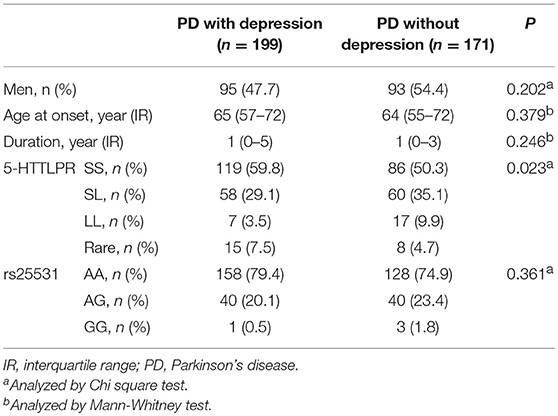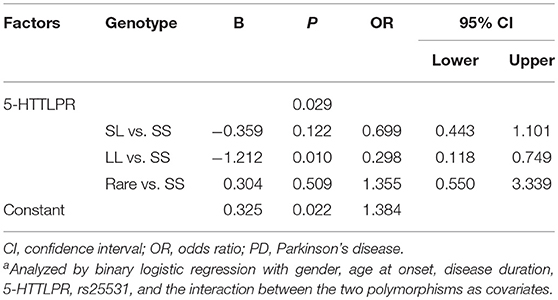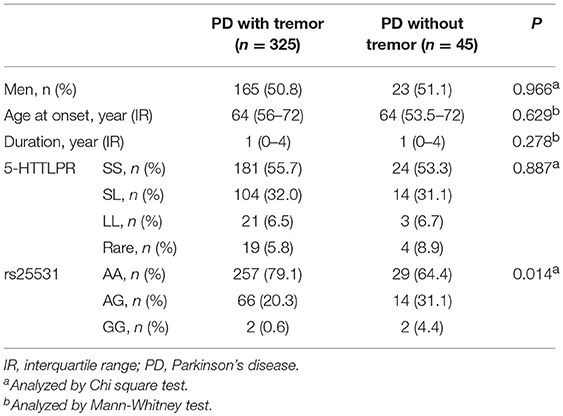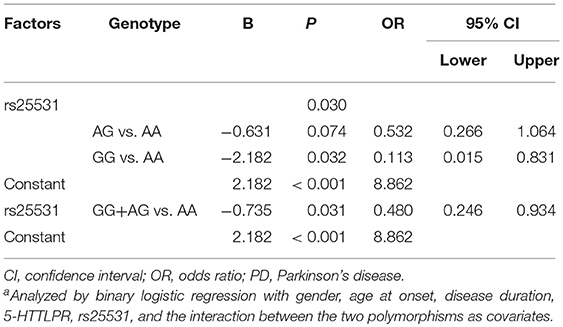- 1Department of Neurology, The First People's Hospital of Jiande, Hangzhou, China
- 2Department of Geriatrics and Neurology, The Second Affiliated Hospital and Yuying Children's Hospital, Wenzhou Medical University, Wenzhou, China
- 3Department of Preventive Medicine, School of Public Health, Wenzhou Medical University, Wenzhou, China
Introduction: Level of serotonin is mainly regulated by the serotonin reuptake transporter encoded by SLC6A4. The promoter region of SLC6A4 bears a repeat polymorphism 5-HTTLPR and a single nucleotide polymorphism rs25531. We have previously studied the association between these two variants and sporadic PD. The objective of the current study was to determine whether the SLC6A4 polymorphisms were associated with key motor and non-motor symptoms of PD.
Methods: A total of 370 PD patients of Han Chinese were included. Associations between the SLC6A4 polymorphisms and PD symptoms including depression, intellectual impairment, tremor and rigidity were analyzed.
Results: 5-HTTLPR was associated with depression in PD patients and presence of the LL genotype was protective against the depression risk. The rs25531 was associated with rest tremor in PD and the A allele serves as a recessive risk allele. No associations were found in the two polymorphisms with respect to intellectual impairment and rigidity in the cohort.
Conclusion: The current study reveals two PD symptoms associated with SLC6A4 polymorphisms, and provides new insight into how serotonergic system genetically participates in the symptomatic progression of PD. Further study is warranted in additional populations.
Introduction
Parkinson's disease (PD) is a common neurodegenerative disease with bradykinesia, rigidity, and rest tremor as its cardinal motor manifestations (1). Non-motor symptoms such as depression, cognitive problems, sleep disorders, and gastrointestinal disturbance have a great impact on life quality in PD patients (2, 3), and are usually present in PD before the onset of motor signs (4).
A hallmark of PD pathology is degeneration of dopaminergic neurons in the substantia nigra, leading to reduction of dopamine output to the striatum (5). In addition to dopamine, dysregulation of serotonin, which is a neurotransmitter linked with cognition and emotional states, also plays an important role in PD progression (6). The serotonin level is mainly regulated by the serotonin reuptake transporter (5-HTT) encoded by the gene SLC6A4. There are two polymorphisms in its promoter region, including a repeat polymorphism 5-HTTLPR and a single nucleotide polymorphism rs25531 located within 5-HTTLPR. 5-HTTLPR consists of 14-repeat and 16-repeat variants, as well as several rare variants such as 15-, 19-, 20-, or 22- repeat. The 14-repeat and 16-repeat elements are denoted as the long (L) allele and the short (S) allele, respectively (7). Both 5-HTTLPR and rs25531 have been suggested in regulation of the 5-HTT expression, collectively or separately (8–10).
We have previously studied the association between sporadic PD and SLC6A4 polymorphisms in a cohort of 504 patients and 504 controls (7). The objective of the current study was to determine whether the SLC6A4 polymorphisms were associated with key symptoms of PD. Rest tremor and rigidity are two of the major motor symptoms, while bradykinesia is considered as required for PD diagnosis. Postural instability is typically a feature of more advanced stage (4). Non-motor symptoms include depression, intellectual impairment, thought disorder and motivation deficit. Thought disorder also often appears in the advanced stage (4), while motivation deficit is usually mixed with depression (11). Thus, to test the above hypothesis, motor symptoms including rest tremor and rigidity, and non-motor symptoms including depression and intellectual impairment were characterized and analyzed. Not all the patients of the previous cohort (7) were included in the current study because of the availability and exclusion criteria. Additional participants were then recruited.
Methods
Patients
A total of 370 PD patients (188 men and 182 women) of Han Chinese ethnicity were included in this study. The median age at onset was 64 (interquartile range, 56–72). The patients were diagnosed by two movement disorder neurologists according to the UK Parkinson‘s Disease Society Brain Bank Criteria (12). Patients with a family history of PD or with secondary and atypical parkinsonism were excluded. All subjects participating in the study signed written informed consents. This study was approved by the Ethics Committee of The Second Affiliated Hospital and Yuying Children's Hospital, Wenzhou Medical University.
Symptom Evaluation
The non-motor and motor symptoms were assessed with Unified Parkinson's Disease Rating Scale (UPDRS) by face to face interview and physical examination. Patients were assessed in the practically defined OFF medication state (13). Patients taking antidepressants were excluded. The disease duration was used as an indicator of PD severity. Patients with UPDRS scores of the targeted items at or higher than 2 were classified into the corresponding group of the symptoms as reported previously (14).
Genotyping
Genomic DNA was isolated from peripheral blood using a DNA extraction kit (Tiangen, Beiing, China). The 5-HTTLPR and rs25531 genotypes were determined by polymerase chain reaction-restriction fragment length polymorphism with restriction endonuclease HpaII (New England BioLabs, Beverly, MA) as previously described (7). The primer pair was 5′-TCC TCC GCT TTG GCG CCT CTT CC-3′ and 5′-TGG GGG TTG CAG GGG AGA TCC TG-3′.
Statistical Analysis
Data were analyzed using the statistical package of Predictive Analytics Software 18.0 (PASW, version 18.0) for windows. Kolmogorov-Smirnov test was used for normality test. Differences in age at onset and disease duration between PD subgroups were assessed using Mann-Whitney Test. Differences in gender and genotype frequencies were assessed using Chi square test. Multivariate analysis was performed by binary logistic regression model using stepwise forwards method with gender, age at onset, disease duration, 5-HTTLPR, rs25531, and the interaction between the two polymorphisms as covariates. A two-tailed P < 0.05 was considered statistically significant.
Results
Analysis of SLC6A4 Polymorphisms With PD Depression and Intellectual Impairment
Two non-motor symptoms including depression and intellectual impairment were analyzed in association with 5-HTTLPR and rs25531 variants of SLC6A4 in the PD patients. A significant difference (P = 0.023) in 5-HTTLPR was detected between PD patients with and without depression (Table 1). Further multivariate analysis confirmed that 5-HTTLPR was associated with PD depression (P = 0.029). Patients carrying the LL genotype had reduced risk toward depression in comparison with the major SS carriers (P = 0.01, OR 0.298, 95% CI 0.118–0.749; Table 2). In contrast, no significant difference was found in the variant rs25531 with regard to depression. Neither 5-HTTLPR nor rs25531 was found in association with intellectual impairment in the PD patients (Supplemental Tables S1, S2). But age at onset and disease duration were independent risk factors for intellectual impairment (P = 0.013, OR 1.025, 95% CI 1.005–1.045 and P = 0.01, OR 1.079, 95% CI 1.018–1.144, respectively; Supplemental Table S2).
Analysis of SLC6A4 Polymorphisms With Tremor and Rigidity in PD Patients
Motor symptoms of tremor and rigidity were analyzed to understand their association with SLC6A4 polymorphisms. Results showed that genotypic distribution of rs25531, but not that of 5-HTTLPR, was significantly different between PD patients with and without tremor (P = 0.014; Table 3). Multivariate analysis confirmed that rs25531 was an independent risk factor for tremor in PD patients (P = 0.03) with the GG genotype being protective compared to the AA (P = 0.032, OR 0.113, 95% CI 0.015–0.831; Table 4). Further analysis showed that PD patients carrying GG and AG conferred lower risk toward tremor than the AA carriers (P = 0.031, OR 0.480, 95% CI 0.246–0.934; Table 4), suggesting that A is a recessive risk allele. No significant difference was found in both 5-HTTLPR and rs25531 with regard to rigidity in the patients (Supplemental Tables S3, S4).
Discussion
The symptomatology of PD is heterogeneous. Both genetic and environmental factors are believed to be involved in its progression. By analyzing associations of the SLC6A4 polymorphisms with depression, intellectual impairment, tremor and rigidity, we demonstrate in a currently largest PD cohort that 5-HTTLPR is linked with PD depression and rs25531 is associated with rest tremor.
Extensive evidence have indicated that the 5-HTTLPR is associated with depression risk (15–19). A complicated regulatory mechanism may be involved as suggested in a gene-by-environment study where the association is only present in condition of stressful life events (15). The PD-associated depression exhibits lesser self-punitive behavior and greater anxiety (20), and the depressive symptoms often fluctuate with motor fluctuations (21). As earlier noted, 5-HTTLPR is a functional repeat polymorphism and the S allele leads to reduced 5-HTT expression and serotonin uptake compared to the L allele (22). Different from Caucasians whose SS genotype accounts for 22%, the LL genotype is instead the minor form in Asians and as in our population (23). Our results show that 5-HTTLPR is associated with depression in PD patients with the minor LL genotype serving a protective form. In comparison, four previous studies in smaller sample size displayed mixed results. Two of them in a sample size of 72 and 32, respectively, displayed similar results that patients carrying the LL genotype of 5-HTTLPR were less depressed than the SS and/or SL carriers (24, 25). Nonetheless, other two studies with 89 and 306 patients, respectively, did not find association between 5-HTTLPR and PD depression (26, 27). As a note, some of the PD patients were taking antidepressant medication when their clinical symptoms were evaluated in these two studies (26, 27). Such cases were excluded in the current study, while no relevant information was disclosed in the former two studies (24, 25).
Highlighted should be that we firstly report an association between rs25531 and PD tremor with its A allele as a recessive risk allele. Interestingly, rest tremor is indeed considered to be more likely related to serotonin dysfunction than to dopamine deficiency as suggested by post-mortem and SERT imaging results (28–30). Serotoninergic antidepressant drugs have long been proved effective in alleviating functional tremor (31). However, the results of the antidepressants for PD-associated tremor appear mixed. For instance, a study in 25 PD patients reported that mirtazapine might alleviate rest tremor (32). But two duloxetine-treated PD patients showed an exacerbation of tremor in a multicenter randomized study (33), which however was not seen in another study of patients treated with duloxetine (34). Moreover, an animal study showed that administration of fluoxetine exacerbated oral tremor (35). Similar to 5-HTTLPR, rs25531 is also a functional polymorphism with the G allele leading to reduced efficiency of HTT transcription (9). It has been reported that 5-HTTLPR affects brain cortical development and the functionality of related brain circuitries, particularly between perigenual cingulate and amygdala, thus contributing its genetic susceptibility to depression (36). Nonetheless, it remains to be further explored how rs25531 is mechanistically involved in the modulation of PD tremor. At the least, our results provide further evidence linking serotonin dysfunction to the occurrence of rest tremor in PD.
The SLC6A4 polymorphisms are not associated with intellectual impairment and rigidity in the patients. However, our results suggest that the cognitive disturbance is related to disease duration and age at onset. While the role of age at onset appears disputable, it is widely recognized that disease duration is associated with dementia in PD (37–39). The current study was initially designed for PD association study (7), and not specifically aimed for the non-motor symptoms. Thus, the main method used was the UPDRS score assessment, instead of a specific scale for cognitive impairment or depression, which otherwise should have been more informative. Also, the number of certain genotypes is limited such as the GG of rs25531. To consolidate our finding, we analyzed the association by comparing GG+AG vs. AA and the results showed similar. Nonetheless, future investigations are warranted to confirm our findings in additional populations.
In conclusion, the current study suggests a role of SLC6A4 polymorphisms in risk toward PD motor and non-motor symptoms. Specifically, our results are in support that 5-HTTLPR modulates PD depression, and for the first time show that rs25531 is associated with rest tremor in PD, thus providing new insight into how serotonergic system genetically participates in the symptomatic progression of PD.
Author Contributions
J-YW and J-HZ conceived and designed the study. Q-YF, J-YW, XZ, J-HH, and S-GZ collected samples, acquired and analyzed the data. C-PH provided statistical support and analysis. J-YW and J-HZ interpreted the results and drafted the manuscript. XZ and J-HZ supervised the study. All authors have read, revised, and approved the final version of the manuscript.
Funding
The study was supported by funding from Zhejiang Provincial Natural Science Foundation (LD19H090001 and LZ19H090002), National Natural Science Foundation of China (81571087, 81771380, 81771510, and 81801271), Zhejiang Provincial Medical Technology Program (2018KY120), Wenzhou Municipal Science and Technology Bureau (Y20170071 and C20170003).
Conflict of Interest Statement
The authors declare that the research was conducted in the absence of any commercial or financial relationships that could be construed as a potential conflict of interest.
Acknowledgments
The authors are thankful to their colleagues for clinical data collection and management of patients. The authors appreciate all of the subjects participating in this study.
Supplementary Material
The Supplementary Material for this article can be found online at: https://www.frontiersin.org/articles/10.3389/fneur.2019.00333/full#supplementary-material
References
1. Postuma RB, Berg D, Stern M, Poewe W, Olanow CW, Oertel W, et al. MDS clinical diagnostic criteria for Parkinson's disease. Mov Disord. (2015) 30:1591–601. doi: 10.1002/mds.26424
2. Skorvanek M, Rosenberger J, Minar M, Grofik M, Han V, Groothoff JW, et al. Relationship between the non-motor items of the MDS-UPDRS and Quality of Life in patients with Parkinson's disease. J Neurol Sci. (2015) 353:87–91. doi: 10.1016/j.jns.2015.04.013
3. Hughes KC, Gao X, Baker JM, Stephen C, Kim IY, Valeri L, et al. Non-motor features of Parkinson's disease in a nested case-control study of US men. J Neurol Neurosurg Psychiatry. (2018) 89:1288–95. doi: 10.1136/jnnp-2018-318275
4. Kalia LV, Lang AE. Parkinson's disease. Lancet. (2015) 386:896–912. doi: 10.1016/S0140-6736(14)61393-3
5. Dickson DW, Braak H, Duda JE, Duyckaerts C, Gasser T, Halliday GM, et al. Neuropathological assessment of Parkinson's disease: refining the diagnostic criteria. Lancet Neurol. (2009) 8:1150–7. doi: 10.1016/S1474-4422(09)70238-8
6. Fox SH, Chuang R, Brotchie JM. Serotonin and Parkinson's disease: on movement, mood, and madness. Mov Disord. (2009) 24:1255–1266. doi: 10.1002/mds.22473
7. Zhang X, Cheng X, Hu YB, Lai JM, You H, Hu PL, et al. Serotonin transporter polymorphic region 5-HTTLPR modulates risk for Parkinson's disease. Neurobiol Aging. (2014) 35:1957.e1959–1957.e1914. doi: 10.1016/j.neurobiolaging.2014.03.002
8. Nakamura M, Ueno S, Sano A, Tanabe H. The human serotonin transporter gene linked polymorphism (5-HTTLPR) shows ten novel allelic variants. Mol Psychiatry. (2000) 5:32–8. doi: 10.1038/sj.mp.4000698
9. Hu XZ, Lipsky RH, Zhu G, Akhtar LA, Taubman J, Greenberg BD, et al. Serotonin transporter promoter gain-of-function genotypes are linked to obsessive-compulsive disorder. Am J Hum Genet. (2006) 78:815–26. doi: 10.1086/503850
10. Wendland JR, Martin BJ, Kruse MR, Lesch KP, Murphy DL. Simultaneous genotyping of four functional loci of human SLC6A4, with a reappraisal of 5-HTTLPR and rs25531. Mol Psychiatry. (2006) 11:224–6. doi: 10.1038/sj.mp.4001789
11. Kendler KS. The genealogy of major depression: symptoms and signs of melancholia from 1880 to 1900. Mol Psychiatry. (2017) 22:1539–53. doi: 10.1038/mp.2017.148
12. Hughes AJ, Daniel SE, Kilford L, Lees AJ. Accuracy of clinical diagnosis of idiopathic Parkinson's disease: a clinico-pathological study of 100 cases. J Neurol Neurosurg Psychiatry. (1992) 55:181–4.
13. Bordelon YM, Hays RD, Vassar SD, Diaz N, Bronstein J, Vickrey BG. Medication responsiveness of motor symptoms in a population-based study of Parkinson disease. Parkinsons Dis. (2011) 2011:967839. doi: 10.4061/2011/967839
14. Starkstein SE, Merello M. The Unified Parkinson's Disease Rating Scale: validation study of the mentation, behavior, and mood section. Mov Disord. (2007) 22:2156–61. doi: 10.1002/mds.21521
15. Caspi A, Sugden K, Moffitt TE, Taylor A, Craig IW, Harrington H, et al. Influence of life stress on depression: moderation by a polymorphism in the 5-HTT gene. Science. (2003) 301:386–9. doi: 10.1126/science.1083968
16. Willeit M, Praschak-Rieder N, Neumeister A, Zill P, Leisch F, Stastny J, et al. A polymorphism (5-HTTLPR) in the serotonin transporter promoter gene is associated with DSM-IV depression subtypes in seasonal affective disorder. Mol Psychiatry. (2003) 8:942–6. doi: 10.1038/sj.mp.4001392
17. Clarke H, Flint J, Attwood AS, Munafo MR. Association of the 5- HTTLPR genotype and unipolar depression: a meta-analysis. Psychol Med. (2010) 40:1767–78. doi: 10.1017/S0033291710000516
18. Goldman N, Glei DA, Lin YH, Weinstein M. The serotonin transporter polymorphism (5-HTTLPR): allelic variation and links with depressive symptoms. Depress Anxiety. (2010) 27:260–9. doi: 10.1002/da.20660
19. Chang CC, Chang HA, Fang WH, Chang TC, Huang SY. Gender-specific association between serotonin transporter polymorphisms (5-HTTLPR and rs25531) and neuroticism, anxiety and depression in well-defined healthy Han Chinese. J Affect Disord. (2017) 207:422–8. doi: 10.1016/j.jad.2016.08.055
20. Cummings JL. Depression and Parkinson's disease: a review. Am J Psychiatry. (1992) 149:443–54. doi: 10.1176/ajp.149.4.443
21. van der Velden RMJ, Broen MPG, Kuijf ML, Leentjens AFG. Frequency of mood and anxiety fluctuations in Parkinson's disease patients with motor fluctuations: a systematic review. Mov Disord. (2018) 33:1521–7. doi: 10.1002/mds.27465
22. Lesch KP, Bengel D, Heils A, Sabol SZ, Greenberg BD, Petri S, et al. Association of anxiety-related traits with a polymorphism in the serotonin transporter gene regulatory region. Science. (1996) 274:1527–31.
23. Iurescia S, Seripa D, Rinaldi M. Role of the 5-HTTLPR and SNP promoter polymorphisms on serotonin transporter gene expression: a closer look at genetic architecture and in vitro functional studies of common and uncommon allelic variants. Mol Neurobiol. (2016) 53:5510–26. doi: 10.1007/s12035-015-9409-6
24. Menza MA, Palermo B, DiPaola R, Sage JI, Ricketts MH. Depression and anxiety in Parkinson's disease: possible effect of genetic variation in the serotonin transporter. J Geriatr Psychiatry Neurol. (1999) 12:49–52. doi: 10.1177/089198879901200202
25. Mossner R, Henneberg A, Schmitt A, Syagailo YV, Grassle M, Hennig T, et al. Allelic variation of serotonin transporter expression is associated with depression in Parkinson's disease. Mol Psychiatry. (2001) 6:350–2. doi: 10.1038/sj.mp.4000849
26. Burn DJ, Tiangyou W, Allcock LM, Davison J, Chinnery PF. Allelic variation of a functional polymorphism in the serotonin transporter gene and depression in Parkinson's disease. Parkinsonism Relat Disord. (2006) 12:139–41. doi: 10.1016/j.parkreldis.2005.11.005
27. Zhang JL, Yang JF, Chan P. No association between polymorphism of serotonin transporter gene and depression in Parkinson's disease in Chinese. Neurosci Lett. (2009) 455:155–8. doi: 10.1016/j.neulet.2009.03.037
28. Benamer HT, Patterson J, Wyper DJ, Hadley DM, Macphee GJ, Grosset DG. Correlation of Parkinson's disease severity and duration with 123I-FP-CIT SPECT striatal uptake. Mov Disord. (2000) 15:692–8. doi: 10.1002/1531-8257(200007)15:4<692::AID-MDS1014>3.0.CO;2-V
29. Politis M, Niccolini F. Serotonin in Parkinson's disease. Behav Brain Res. (2015) 277:136–45. doi: 10.1016/j.bbr.2014.07.037
30. Pasquini J, Ceravolo R, Qamhawi Z, Lee JY, Deuschl G, Brooks DJ, et al. Progression of tremor in early stages of Parkinson's disease: a clinical and neuroimaging study. Brain. (2018) 141:811–21. doi: 10.1093/brain/awx376
31. Schneider SA, Deuschl G. The treatment of tremor. Neurotherapeutics. (2014) 11:128–38. doi: 10.1007/s13311-013-0230-5
32. Gordon PH, Pullman SL, Louis ED, Frucht SJ, Fahn S. Mirtazapine in Parkinsonian tremor. Parkinsonism Relat Disord. (2002) 9:125–6. doi: 10.1016/S1353-8020(02)00011-1
33. Takahashi M, Tabu H, Ozaki A, Hamano T, Takeshima T, REBORN study group. Antidepressants for depression, apathy, and gait instability in Parkinson's disease: a multicenter randomized study. Intern Med. (2019) 58:361–8. doi: 10.2169/internalmedicine.1359-18
34. Bonuccelli U, Meco G, Fabbrini G, Tessitore A, Pierantozzi M, Stocchi F, et al. A non-comparative assessment of tolerability and efficacy of duloxetine in the treatment of depressed patients with Parkinson's disease. Expert Opin Pharmacother. (2012) 13:2269–80. doi: 10.1517/14656566.2012.736490
35. Podurgiel SJ, Milligan MN, Yohn SE, Purcell LJ, Contreras-Mora HM, Correa M, et al. Fluoxetine administration exacerbates oral tremor and striatal dopamine depletion in a rodent pharmacological model of Parkinsonism. Neuropsychopharmacology. (2015) 40:2240–7. doi: 10.1038/npp.2015.69
36. Pezawas L, Meyer-Lindenberg A, Drabant EM, Verchinski BA, Munoz KE, Kolachana BS, et al. 5-HTTLPR polymorphism impacts human cingulate-amygdala interactions: a genetic susceptibility mechanism for depression. Nat Neurosci. (2005) 8:828–34. doi: 10.1038/nn1463
37. Hughes TA, Ross HF, Musa S, Bhattacherjee S, Nathan RN, Mindham RH, et al. A 10-year study of the incidence of and factors predicting dementia in Parkinson's disease. Neurology. (2000) 54:1596–602. doi: 10.1212/WNL.54.8.1596
38. Aarsland D, Kvaloy JT, Andersen K, Larsen JP, Tang MX, Lolk A, et al. The effect of age of onset of PD on risk of dementia. J Neurol. (2007) 254:38–45. doi: 10.1007/s00415-006-0234-8
Keywords: Parkinson's disease, serotonin reuptake transporter, SLC6A4, depression, tremor
Citation: Wang J-Y, Fan Q-Y, He J-H, Zhu S-G, Huang C-P, Zhang X and Zhu J-H (2019) SLC6A4 Repeat and Single-Nucleotide Polymorphisms Are Associated With Depression and Rest Tremor in Parkinson's Disease: An Exploratory Study. Front. Neurol. 10:333. doi: 10.3389/fneur.2019.00333
Received: 17 January 2019; Accepted: 19 March 2019;
Published: 09 April 2019.
Edited by:
Oury Monchi, University of Calgary, CanadaReviewed by:
Santiago Perez-Lloret, National Council for Scientific and Technical Research (CONICET), ArgentinaChon-Haw Tsai, China Medical University Hospital, Taiwan
Copyright © 2019 Wang, Fan, He, Zhu, Huang, Zhang and Zhu. This is an open-access article distributed under the terms of the Creative Commons Attribution License (CC BY). The use, distribution or reproduction in other forums is permitted, provided the original author(s) and the copyright owner(s) are credited and that the original publication in this journal is cited, in accordance with accepted academic practice. No use, distribution or reproduction is permitted which does not comply with these terms.
*Correspondence: Xiong Zhang, emhhbmd4aW9uZzk4QGdtYWlsLmNvbQ==
Jian-Hong Zhu, amh6aHVAd211LmVkdS5jbg==
†These authors have contributed equally to this work
 Jian-Yong Wang1,2,3†
Jian-Yong Wang1,2,3† Xiong Zhang
Xiong Zhang Jian-Hong Zhu
Jian-Hong Zhu


